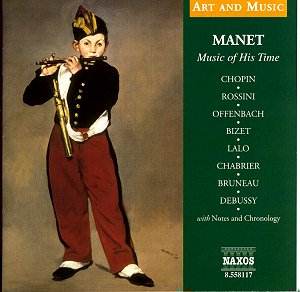Naxos is to be applauded for the concept of
this series. Art and music are intimately bound together (exactly
how, though, provides much academic fodder). The combination of
carefully chosen repertoire, an extended and insightful accompanying
booklet essay (by Hugh Griffith) and a chronology is indicative
of the care which has gone into this issue. The booklet firstly
considers Paris at the time of Manet, then the man himself, then
the music on the disc. All this makes for fascinating reading
and the text is interspersed with several Manets: Olympia
(1863); Madame Manet au piano (1868); Emile Zola
(1868); Argenteuil (1874); Nana (1877).
Choice of repertoire mixes the familiar with
excursions down some byways. Inevitably, this is an uneven hotch-potch
of performances and an ingenious way to regurgitate back-catalogue
material. Perhaps understandably, the programmers opt to begin
and end with two of the jewels in Naxos’s exclusive artists roster:
Idil Beret (in Chopin) and the Kodály String Quartet (in
Debussy). Beret plays the Chopin Waltzes with a sensitive rubato
and a keen awareness of voice-leading, with subsidiary voices
subtly highlighted rather than forced on the listener. The nostalgic
world of Op. 64 No. 2 is well shaded, and a light and flighty
Op. 70 No. 1 rounds off her offering. Naxos’s ‘house’ quartet
close the disc with a stylish performance of the first movement
of Debussy’s G minor String Quartet.
An excerpt from Rossini’s Stabat Mater
brings with it a nicely balanced line-up of soloists (Patrizia
Pace, Gloria Scalchi, Antonio Siragusa and Carlo Colombara) and
a good choir and orchestra (Hungarian State Opera Chorus and Orchestra,
all under Pier Giorgio Morandi). This is slow and delicate, and
full of feeling, but is marred by an over-zealous tenor and a
recording that needs more depth. Offenbach’s Overture to La
Vie parisienne, played by the Polish NRSO under Richard Hayman,
is fizzy and fun.
The truly interesting curio on the menu, though,
is Les Fiançailles au moulin from Alfred Bruneau’s
:L’Attaque du moulin. Bruneau was a student of Massenet,
and his music is accordingly well crafted and well behaved but
also fun. The performance is more than adequately committed (the
Rhenish Philharmonic Orchestra is conducted by James Lockhart).
Pianist Georges Rabol, playing three of Chabrier’s
Pièces pittoresques, realises these pieces well,
especially the sweet and lovely ‘Idylle’. The excerpt from Lalo’s
Symphonie espagnole, played by Marat Bisengaliev with the
Polish NRSO under Johannes Wildner, is dramatic if not life-changing.
An interesting idea, then, and worth the fiver
to spend a couple of hours investigating Manet’s world.
Colin Clarke
see also review
by Paul Shoemaker

